Vertical garden design is an exciting way to bring greenery into small spaces, allowing you to create lush, living walls that enhance both aesthetics and air quality. This style of gardening lets you maximize your space, whether you’re working with a tiny apartment balcony or a spacious backyard, by incorporating a variety of plants in a vertical arrangement. From herbs to flowering plants, the possibilities are endless and can transform any dull wall into a stunning focal point.
Choosing the Right Plants for Vertical Gardens
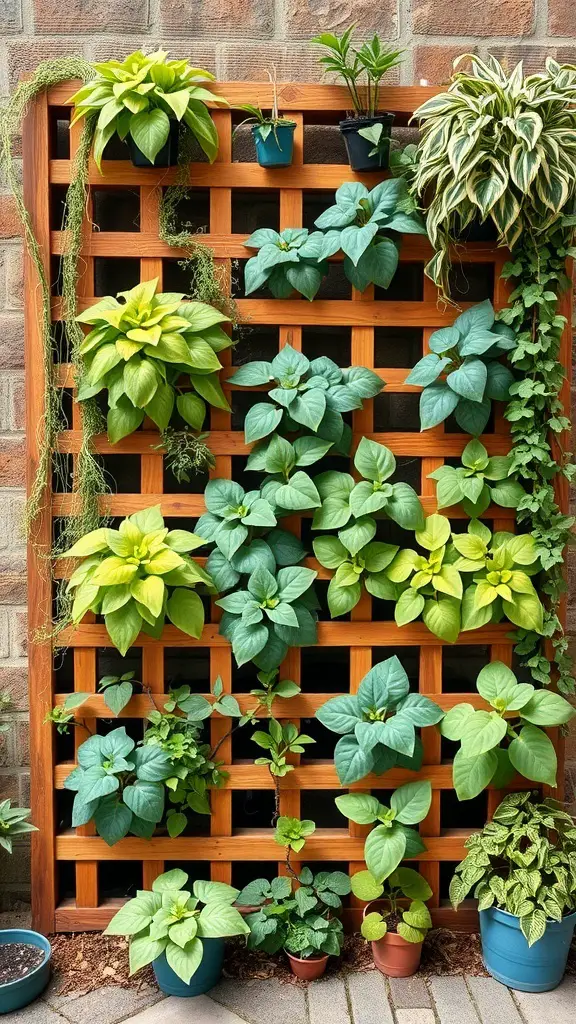
Vertical gardens are a fantastic way to bring greenery into small spaces. The image shows a beautifully arranged vertical garden with various plants thriving on a wooden trellis. This setup not only saves space but also adds a unique touch to any wall.
When selecting plants for your vertical garden, think about the light conditions. Some plants prefer bright light, while others thrive in shade. In the image, you can see a mix of leafy greens and trailing vines, which create a lush look. Plants like pothos and philodendrons are great choices for beginners.
Consider the maintenance level of the plants. Some require more care than others. The plants in the image appear to be low-maintenance, making them perfect for busy lifestyles. You can also mix in flowering plants for pops of color.
Another tip is to think about the growth habits of the plants. Some will spread out, while others grow upwards. This variety can create an interesting visual effect. The combination of different shapes and colors in the image showcases how diverse a vertical garden can be.
Lastly, don’t forget about the pots and containers. They should complement the plants and the overall design. The pots in the image are simple yet stylish, enhancing the garden’s aesthetic. Choose containers that fit your style and the needs of your plants.
Creative Structures for Vertical Garden Support
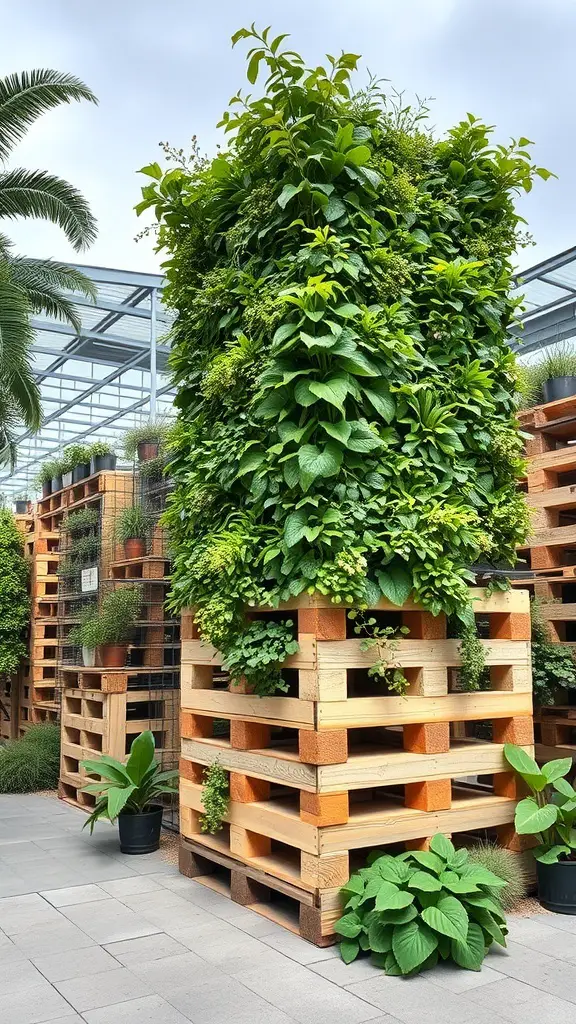
Vertical gardens are a fantastic way to bring greenery into smaller spaces. The image showcases a unique structure made from wooden pallets, stacked to create a vertical garden. This design not only saves space but also adds a rustic charm to any area.
The use of pallets is a clever choice. They are often easy to find and can be repurposed, making them an eco-friendly option. The plants thrive in this setup, with lush greenery cascading down the sides, creating a vibrant display.
Incorporating different types of plants can enhance the visual appeal. Consider mixing herbs, flowers, and foliage for a diverse look. This structure allows for easy access to the plants, making maintenance a breeze.
Overall, using pallets for vertical gardening is a creative and practical solution. It encourages gardening in urban settings where space is limited while adding a touch of nature to your environment.
Seasonal Planting Strategies for Vertical Gardens
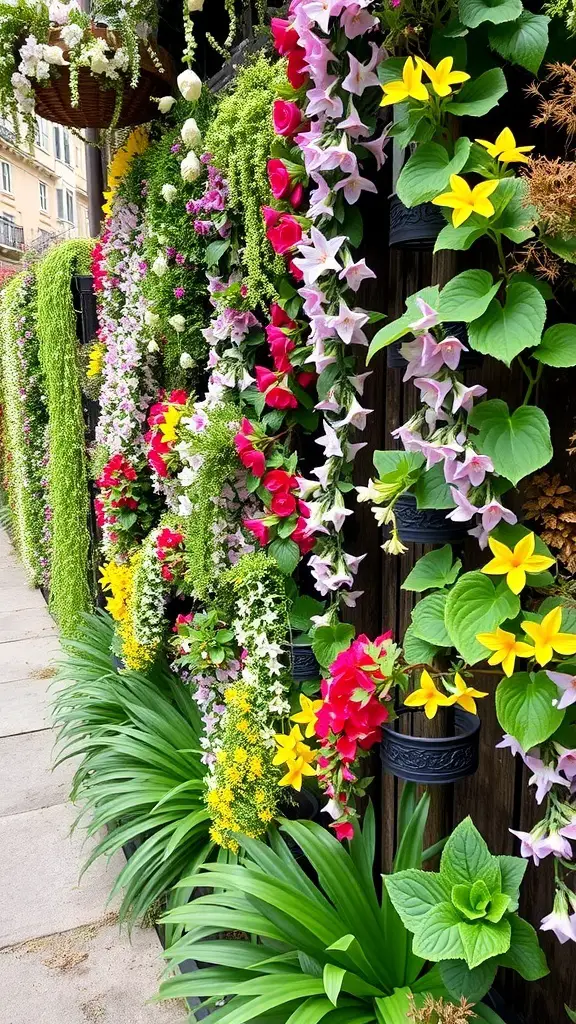
Vertical gardens are a stunning way to bring life to any space. The image shows a vibrant display of flowers and greenery cascading down a wall. This colorful arrangement highlights how seasonal planting can create a dynamic and ever-changing garden.
When planning your vertical garden, think about the seasons. In spring, you can fill your garden with bright blooms like the yellow and pink flowers seen here. These cheerful colors can lift your spirits and make your space feel welcoming.
As summer approaches, consider adding plants that thrive in warmer weather. The lush greens and vibrant hues in the image suggest that a mix of flowering plants can create a lively atmosphere. Choose varieties that bloom at different times to keep your garden looking fresh throughout the season.
In fall, you might want to swap out some plants for those with autumn colors. Incorporating deep reds and oranges can give your vertical garden a cozy feel. Finally, winter can be a time for evergreen plants that provide structure and color, even in the colder months.
By planning your vertical garden with seasonal changes in mind, you can enjoy a beautiful display all year round. The key is to select plants that not only look good together but also thrive in your local climate.
Integrating Vertical Gardens into Interior Design
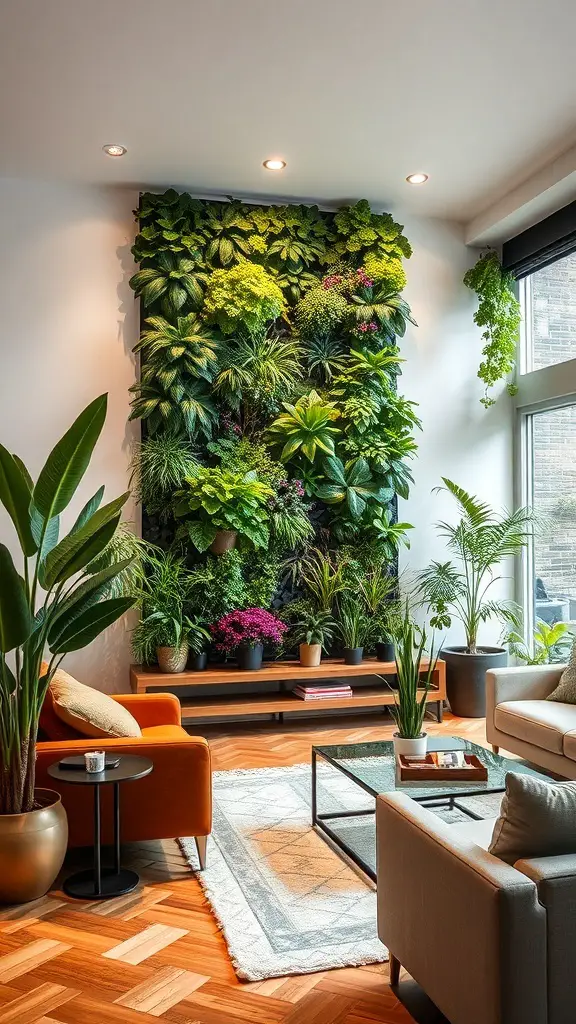
Vertical gardens are a fantastic way to bring nature indoors. The image shows a stunning green wall that adds life to a cozy living space. Lush plants create a vibrant backdrop, making the room feel fresh and inviting.
The arrangement of various plants offers a mix of textures and colors. This not only enhances the visual appeal but also promotes a sense of calm. The plants can improve air quality, making the space healthier to live in.
Incorporating a vertical garden can be as simple as choosing the right wall. Consider a spot that gets enough light and is easily visible. This way, the garden becomes a focal point in the room.
Pairing the green wall with comfortable seating and warm colors, like the orange chair in the image, creates a welcoming atmosphere. Accessories like a coffee table and decorative items can complement the garden, tying the whole look together.
Overall, vertical gardens are not just about aesthetics; they add a touch of nature to our daily lives, making any interior feel more alive.
Maximizing Space in Small Areas with Vertical Gardens
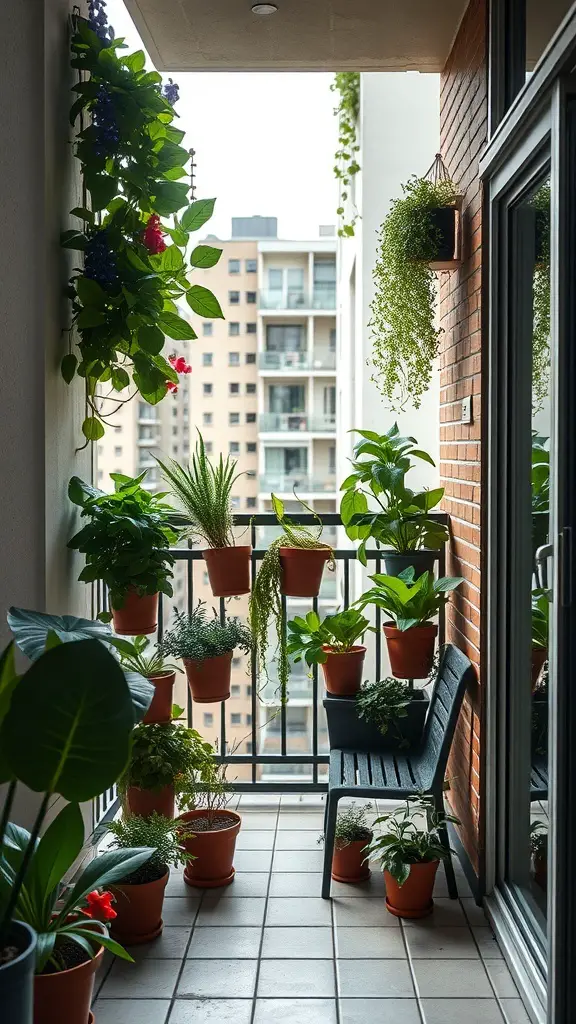
Vertical gardens are a fantastic way to bring life to small spaces. The image shows a charming balcony filled with various plants, showcasing how greenery can thrive even in limited areas. The pots are arranged neatly along the walls, creating a lush environment without taking up much floor space.
This setup not only adds beauty but also improves air quality. The plants chosen for this vertical garden vary in size and type, providing a diverse look. From trailing vines to sturdy ferns, each plant contributes to a vibrant atmosphere.
Using vertical space allows for more room to relax and enjoy the outdoors. The simple bench in the corner invites you to sit and appreciate the greenery. This design encourages creativity, as you can mix and match different plants based on your preferences.
Overall, this vertical garden is a perfect example of how to maximize space while enjoying the benefits of nature. It’s a great way to make any small area feel more inviting and lively.
Vertical Garden Lighting Solutions for Optimal Growth
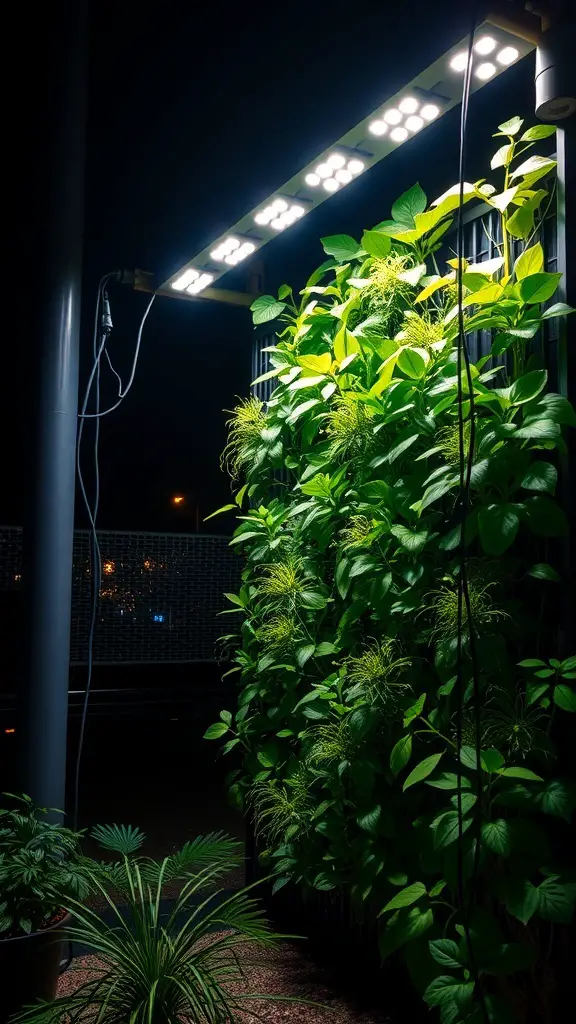
Lighting is a key factor in the success of vertical gardens. The image shows a well-lit vertical garden, showcasing how proper illumination can enhance plant growth. The bright LED lights above the lush greenery provide the necessary light spectrum for photosynthesis, making plants thrive even in low-light conditions.
Using the right type of lighting can make a huge difference. LED grow lights are energy-efficient and can be adjusted to provide the specific wavelengths that plants need. This setup not only supports plant health but also adds a beautiful glow to your space at night.
When planning your vertical garden, think about where to place your lights. Positioning them close to the plants ensures they receive adequate light. You can also use timers to automate the lighting schedule, mimicking natural sunlight cycles.
Incorporating lighting into your vertical garden design not only promotes growth but also creates an inviting atmosphere. Whether it’s for indoor or outdoor gardens, the right lighting can transform your green space into a stunning focal point.
Watering Systems for Efficient Vertical Gardening
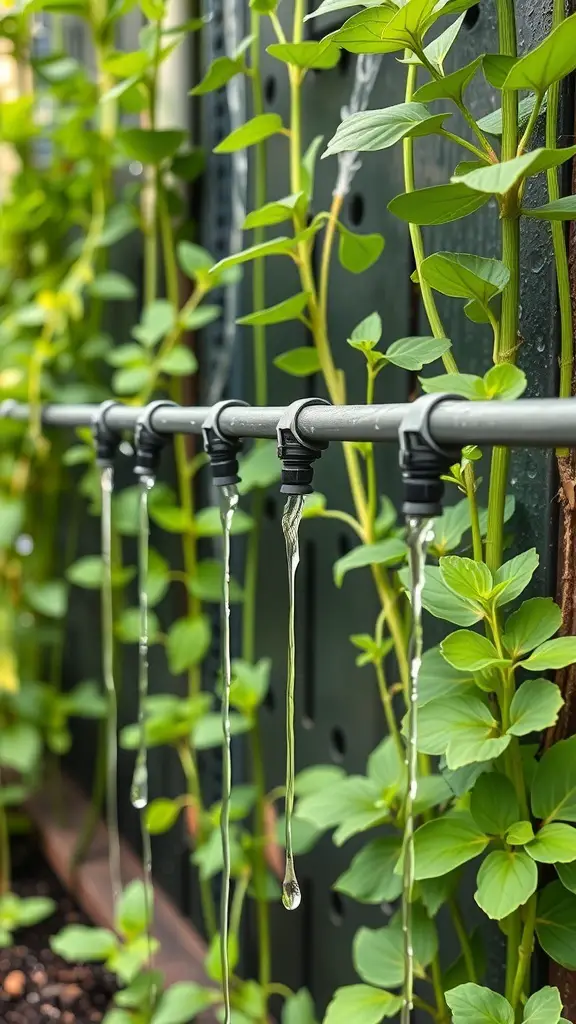
In vertical gardening, having a reliable watering system is key. The image shows a drip irrigation setup, which is perfect for keeping plants hydrated without wasting water. This method delivers water directly to the roots, ensuring that each plant gets what it needs.
Drip systems are easy to install and can be adjusted based on the needs of your plants. The small tubes and emitters allow for precise watering, which is especially useful in a vertical garden where space is limited. This setup helps prevent overwatering and promotes healthy growth.
Another great feature of this system is its efficiency. Water drips slowly, allowing it to soak into the soil rather than running off. This is not just good for the plants; it also conserves water, making it an eco-friendly choice.
When planning your vertical garden, think about how you will water your plants. A drip irrigation system can save you time and effort, letting you enjoy your garden without the hassle of constant watering.
Vertical Garden Maintenance Tips for Longevity
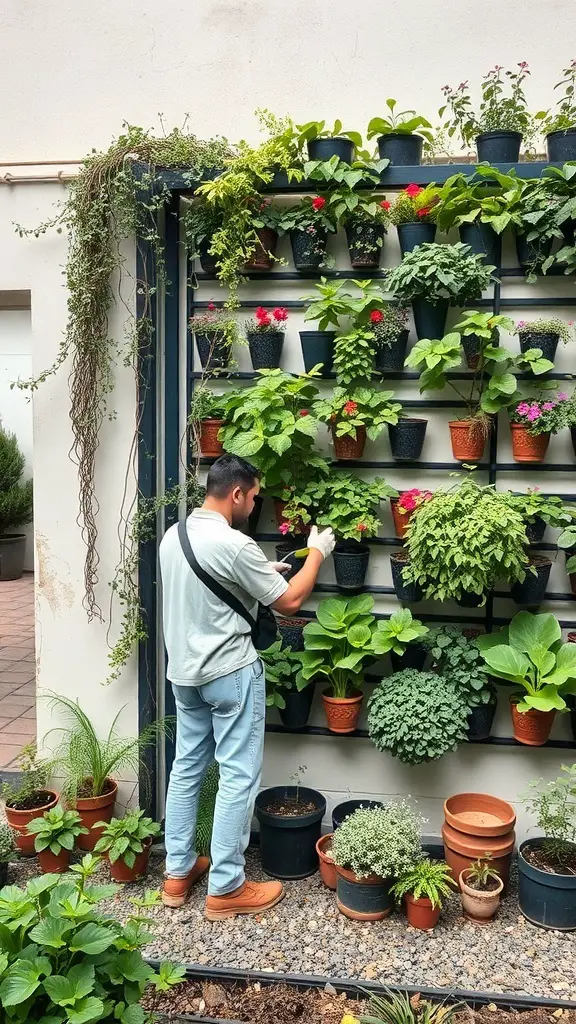
Maintaining a vertical garden can be a rewarding experience. The image shows a person tending to a lush vertical garden filled with various plants. This setup not only beautifies a space but also improves air quality.
Regular watering is key. Make sure to check the moisture levels in the soil. Overwatering can lead to root rot, while underwatering can cause plants to wilt. A good rule of thumb is to water when the top inch of soil feels dry.
Pruning is another important task. Remove dead or yellowing leaves to promote healthy growth. This also helps prevent pests and diseases from spreading. Don’t be afraid to trim back overgrown plants to keep the garden looking neat.
Fertilizing your vertical garden can boost plant health. Use a balanced, slow-release fertilizer every few months. This will provide essential nutrients and support growth.
Lastly, keep an eye on pests. Regularly inspect your plants for any signs of infestation. If you spot any, act quickly to remove them. Natural remedies can often be effective without harming your plants.
Vertical Gardens as Air Purifiers and Natural Decor
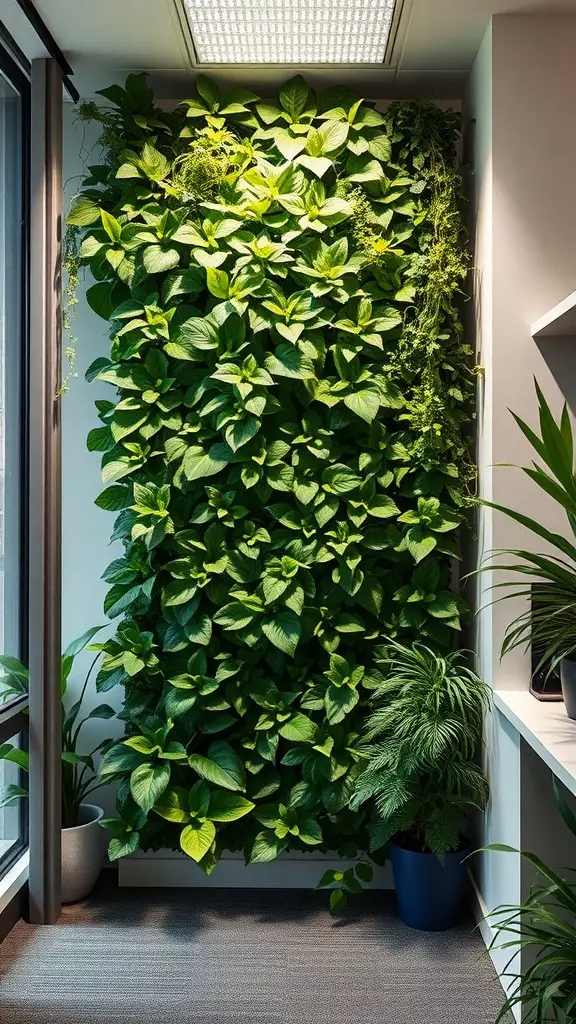
Vertical gardens are not just a trend; they serve multiple purposes. The image shows a lush green wall filled with various plants, creating a beautiful and refreshing space. This living wall can transform any area into a natural oasis.
Plants are known for their ability to purify the air. They absorb carbon dioxide and release oxygen, making indoor environments healthier. The greenery in the image contributes to cleaner air, which is especially beneficial in urban settings where pollution can be a concern.
Besides their air-purifying qualities, vertical gardens add a unique aesthetic to any room. The vibrant greens create a calming effect, making spaces feel more inviting. Whether in a home or office, this natural decor can enhance the overall atmosphere.
Incorporating a vertical garden is a simple way to bring nature indoors. It requires minimal space while offering maximum benefits. With proper care, these green walls can thrive and continue to provide beauty and fresh air for years to come.
Benefits of Vertical Gardens for Urban Environments
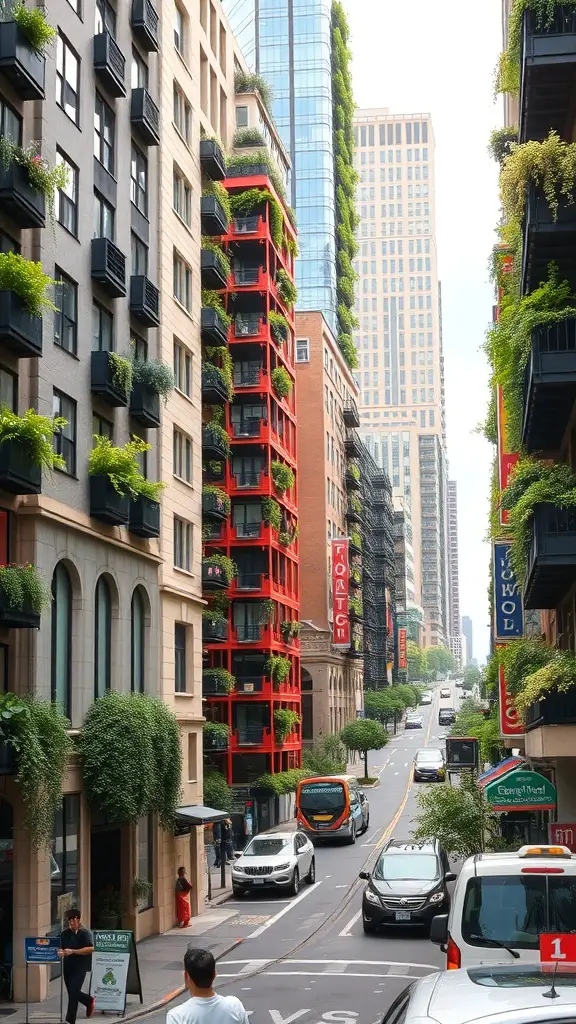
Vertical gardens are a fantastic addition to urban areas. They bring a splash of green to concrete jungles, making the environment more inviting. The image shows buildings adorned with lush greenery, showcasing how vertical gardens can transform a street.
One major benefit is improved air quality. Plants naturally filter pollutants, making the air fresher for everyone. In the image, you can see how the greenery on the buildings contributes to a healthier atmosphere.
Another advantage is the aesthetic appeal. Vertical gardens create a visually striking contrast against urban architecture. The vibrant colors of the plants in the image add life to the buildings, making the area more attractive for residents and visitors alike.
Vertical gardens also help with temperature regulation. They provide insulation for buildings, reducing the need for heating and cooling. This can lead to lower energy costs, which is a win-win for both the environment and your wallet.
Lastly, these gardens promote biodiversity. They offer habitats for various species, encouraging wildlife to thrive in urban settings. The greenery in the image is a perfect example of how vertical gardens can support local ecosystems.
Innovative Vertical Garden Designs Around the World
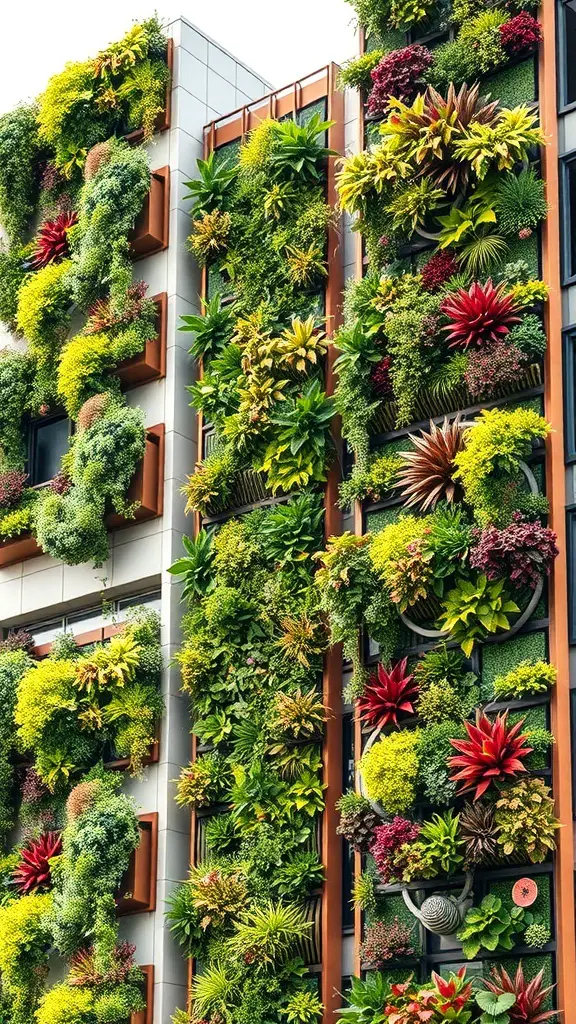
Vertical gardens are a fantastic way to bring nature into urban spaces. The image showcases a stunning example of this trend, featuring a wall covered in lush greenery. Various plants, from vibrant flowers to leafy greens, create a beautiful tapestry of colors and textures.
This design not only enhances the aesthetic appeal of the building but also contributes to better air quality. The combination of different plant species allows for a dynamic look that changes with the seasons. It’s a perfect example of how innovative vertical garden designs can transform ordinary walls into living art.
In cities where space is limited, these gardens provide a practical solution for gardening enthusiasts. They can be installed on balconies, rooftops, or even as standalone installations. This approach makes gardening accessible to everyone, regardless of their available space.
Creating a Vertical Herb Garden for Culinary Use
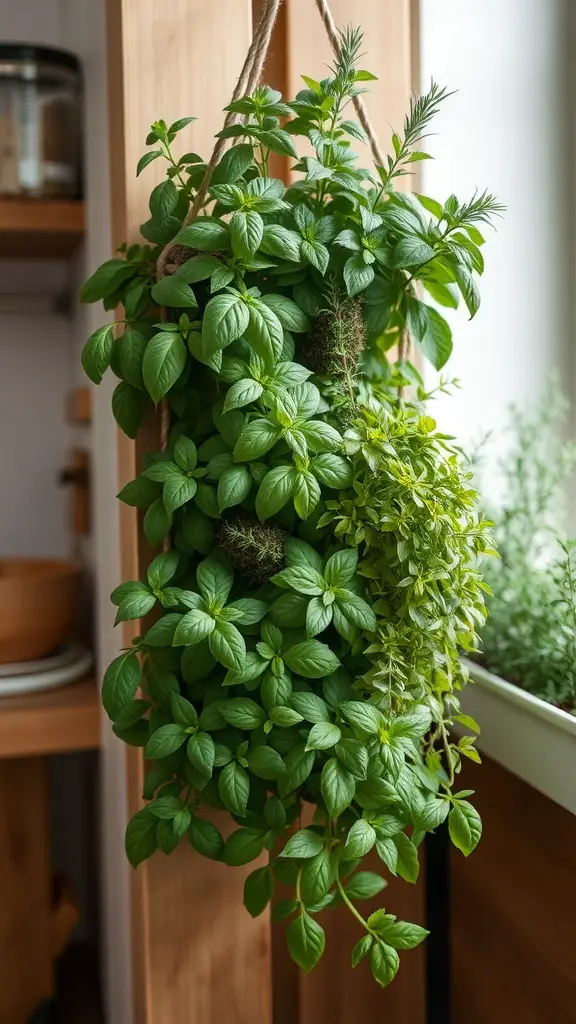
A vertical herb garden is a fantastic way to bring fresh flavors into your kitchen. The image shows a lush arrangement of herbs, perfect for culinary use. Hanging plants like basil, thyme, and oregano not only save space but also add a vibrant touch to your home.
To start your vertical herb garden, choose a sunny spot. Herbs love light, so a window sill or a well-lit wall works great. You can use wall planters or hanging pots to create a beautiful display. Make sure to pick herbs you frequently use in your cooking.
When planting, use good quality potting soil and ensure proper drainage. Water your herbs regularly, but avoid overwatering. Harvesting is easy; just snip off what you need. This encourages new growth and keeps your plants healthy.
Imagine the joy of stepping into your kitchen and grabbing fresh herbs for your meals. It’s not just about cooking; it’s about enjoying the process. A vertical herb garden can be a delightful addition to your culinary adventures.
Color Schemes and Aesthetic Choices for Vertical Gardens
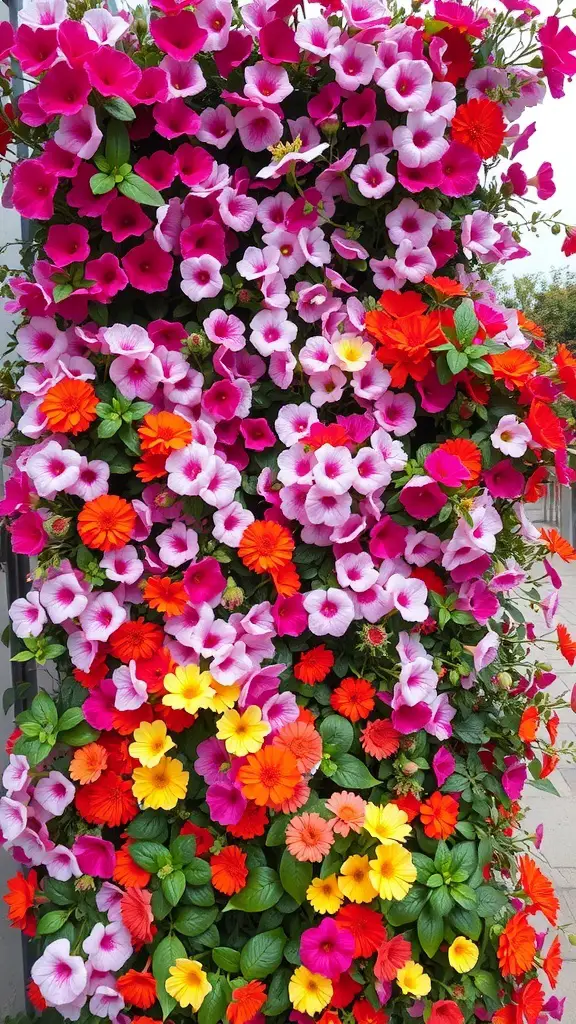
Vertical gardens are a fantastic way to bring life to any space, and color plays a huge role in their appeal. The image shows a stunning array of flowers in vibrant shades of pink, orange, and yellow, creating a lively and cheerful atmosphere. This colorful display not only catches the eye but also invites a sense of joy and warmth.
When designing a vertical garden, think about how colors interact. The combination of pinks and oranges in the image creates a harmonious blend that feels both energetic and inviting. You can choose colors that complement each other or go for a bold contrast to make a statement.
Consider the mood you want to create. Soft pastels can evoke calmness, while bright colors can energize a space. The flowers in the image showcase how a mix of hues can transform a simple wall into a vibrant focal point. This approach can work well in both indoor and outdoor settings.
Using a variety of flower types adds texture and depth to your garden. The layering of colors seen here enhances the visual interest and keeps the eye moving. Whether you prefer a monochromatic scheme or a riot of colors, the key is to balance the elements for a cohesive look.
Vertical Garden Installation Techniques for Beginners
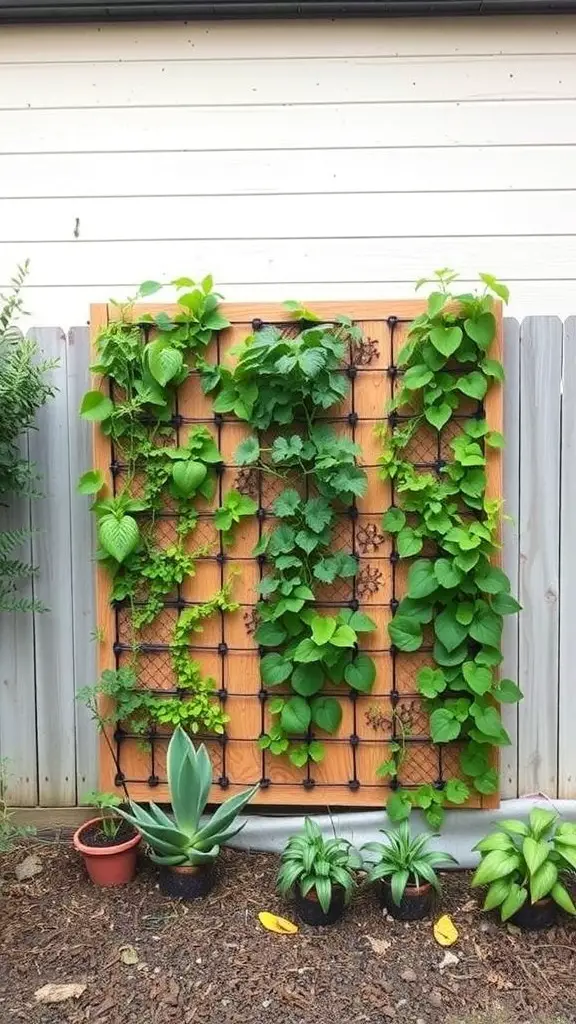
Creating a vertical garden can be a fun and rewarding project. The image shows a beautiful vertical garden setup, featuring a wooden frame with lush green plants climbing up its structure. This design not only saves space but also adds a vibrant touch to any area.
To start your own vertical garden, you’ll need a sturdy frame. The one in the image uses a wooden base, which is both attractive and functional. You can use materials like pallets or trellises for a similar effect. Make sure your frame can support the weight of the plants and soil.
Next, choose your plants wisely. The image showcases a variety of climbing plants that thrive in vertical spaces. Consider plants like ivy, ferns, or even herbs. They not only look great but can also be useful in the kitchen.
Don’t forget about the watering system. Vertical gardens can dry out quickly, so a drip irrigation system or regular watering is key. You want to keep your plants healthy and thriving, just like the ones in the image.
Lastly, enjoy the process! Watching your vertical garden grow can be incredibly satisfying. With a little patience and care, you’ll have a stunning green wall that enhances your space.
Sustainable Practices in Vertical Garden Design
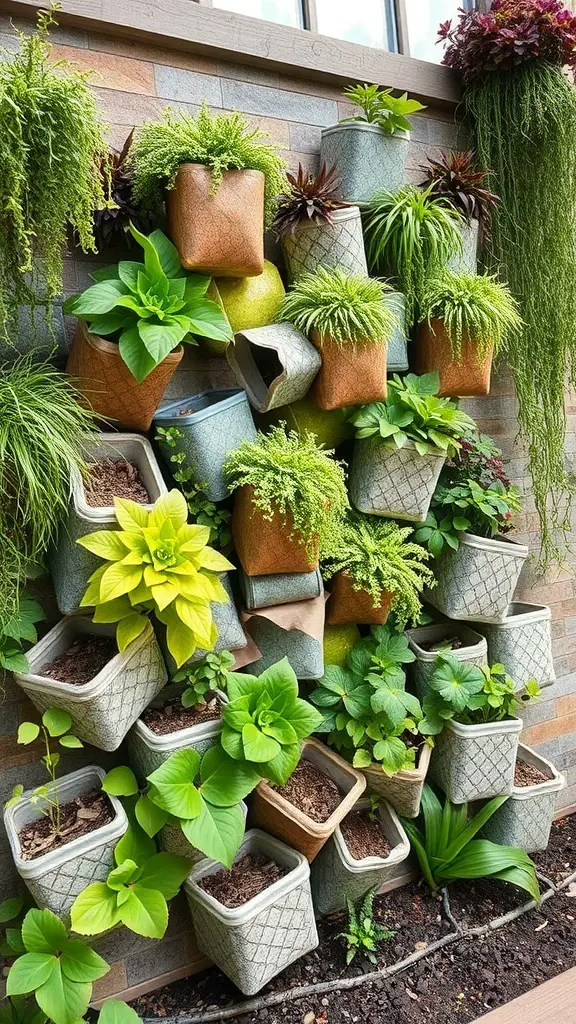
Vertical gardens are not just beautiful; they can also be eco-friendly. The image showcases a stunning vertical garden filled with various plants, arranged in a way that spells out a message. This creative approach highlights how greenery can be integrated into urban spaces.
Using native plants is a smart choice for sustainability. They require less water and maintenance, making them ideal for vertical gardens. The diverse foliage seen in the image suggests a mix of textures and colors, which can attract local wildlife, promoting biodiversity.
Another sustainable practice is the use of recycled materials for the garden structure. The pots and panels can be made from repurposed items, reducing waste. This not only helps the environment but also adds a unique touch to your design.
Water conservation is key in vertical gardens. Incorporating a drip irrigation system can ensure that plants receive just the right amount of moisture. This method minimizes water waste and keeps the plants healthy, as seen in the lush greenery of the image.
Finally, vertical gardens can improve air quality. Plants naturally filter pollutants, making your space healthier. The vibrant plants in the image serve as a reminder of how greenery can enhance both aesthetics and well-being.


